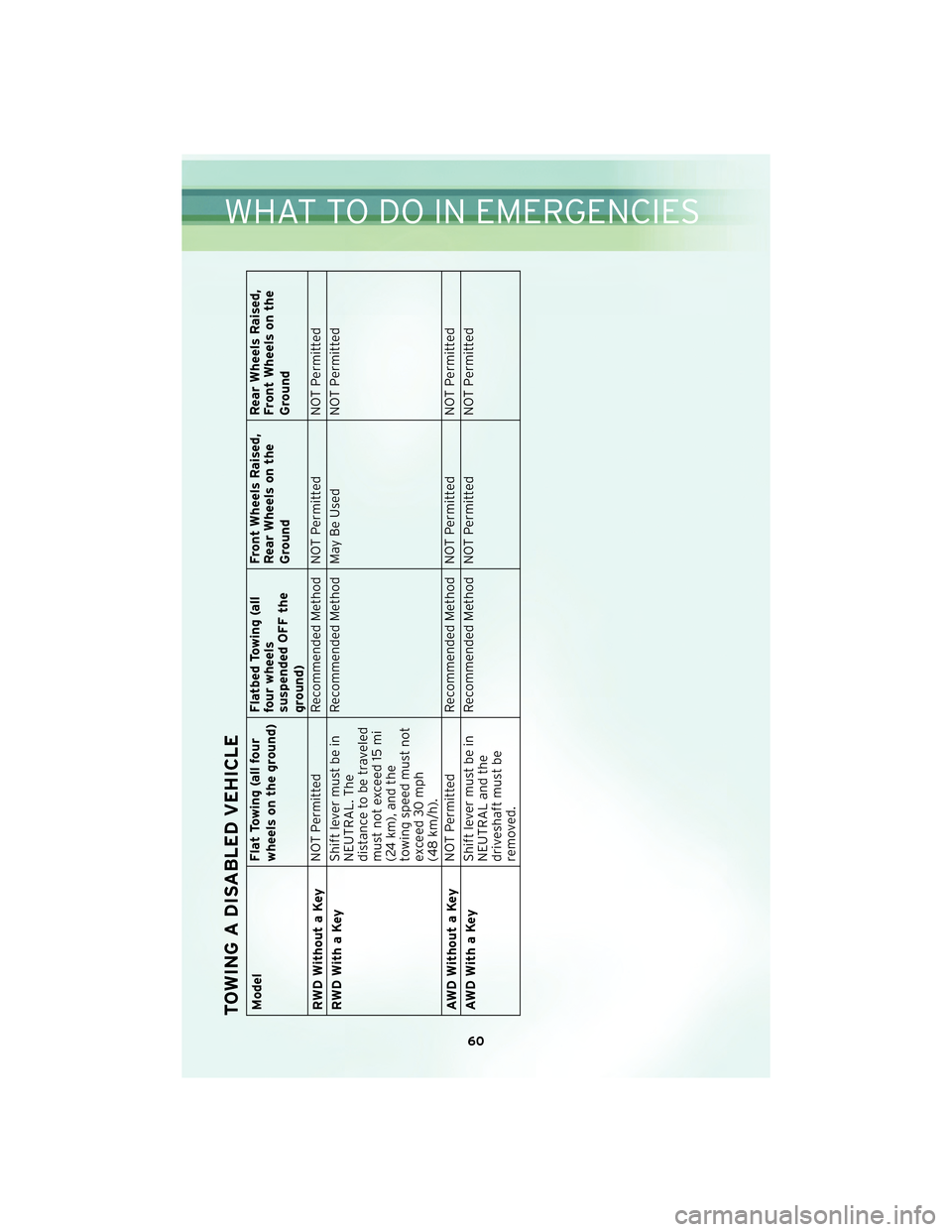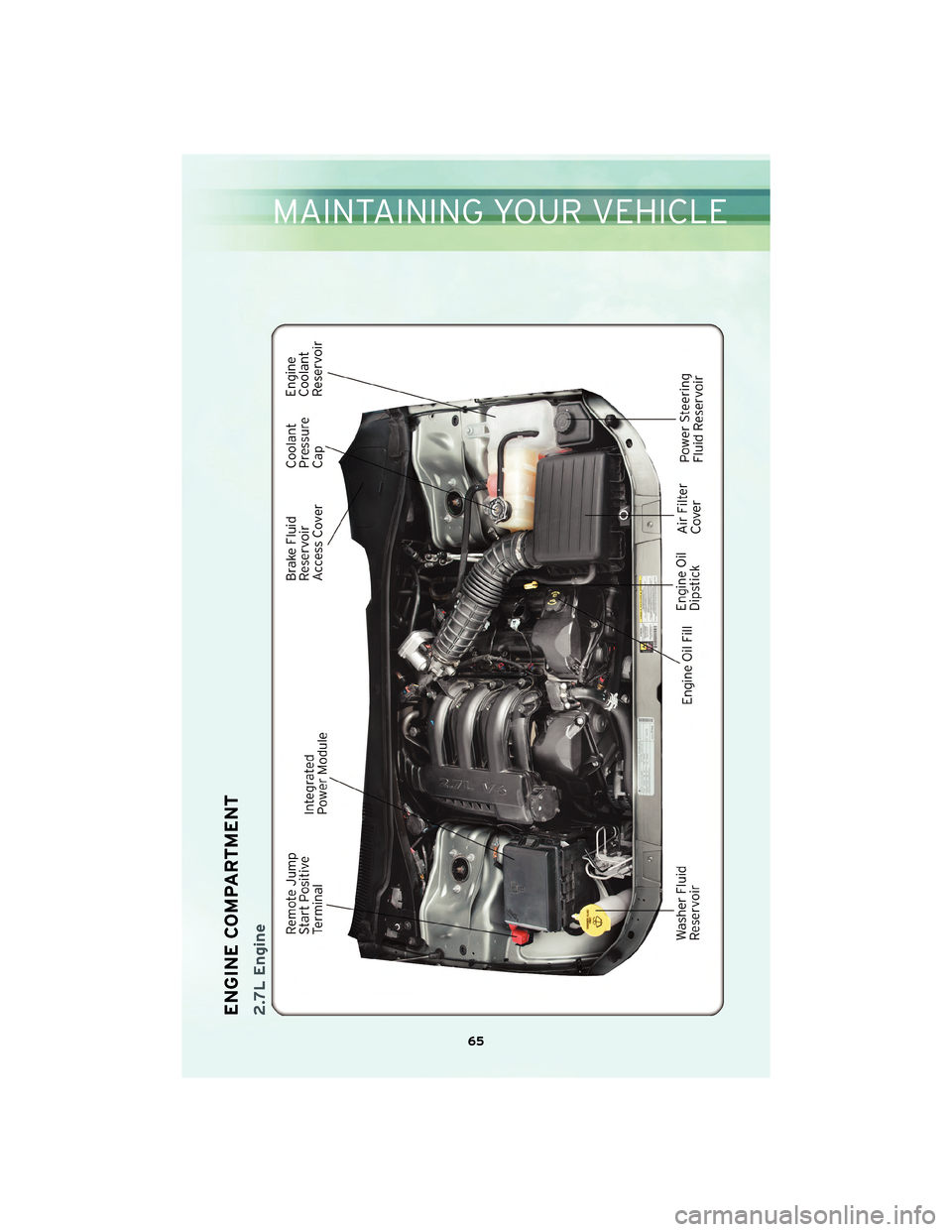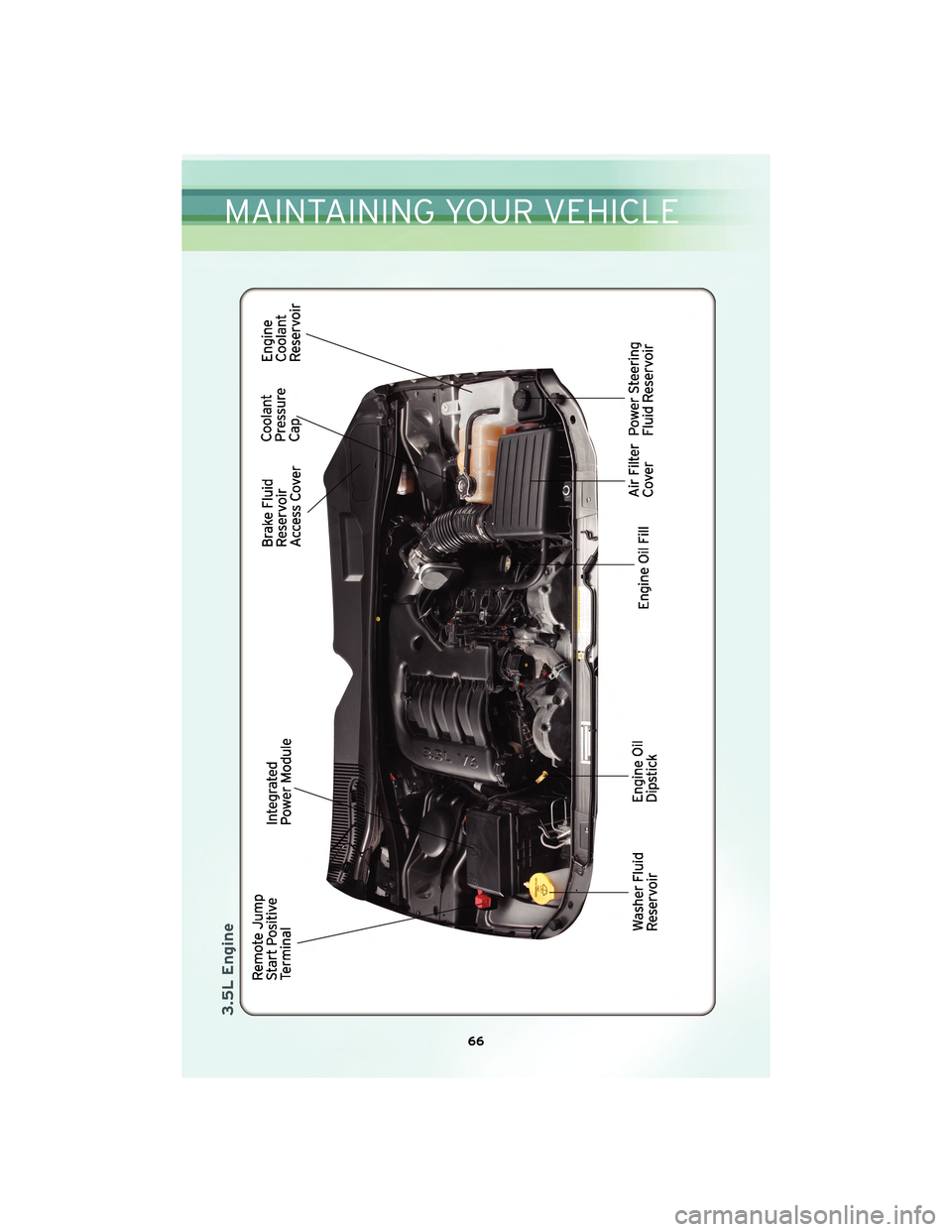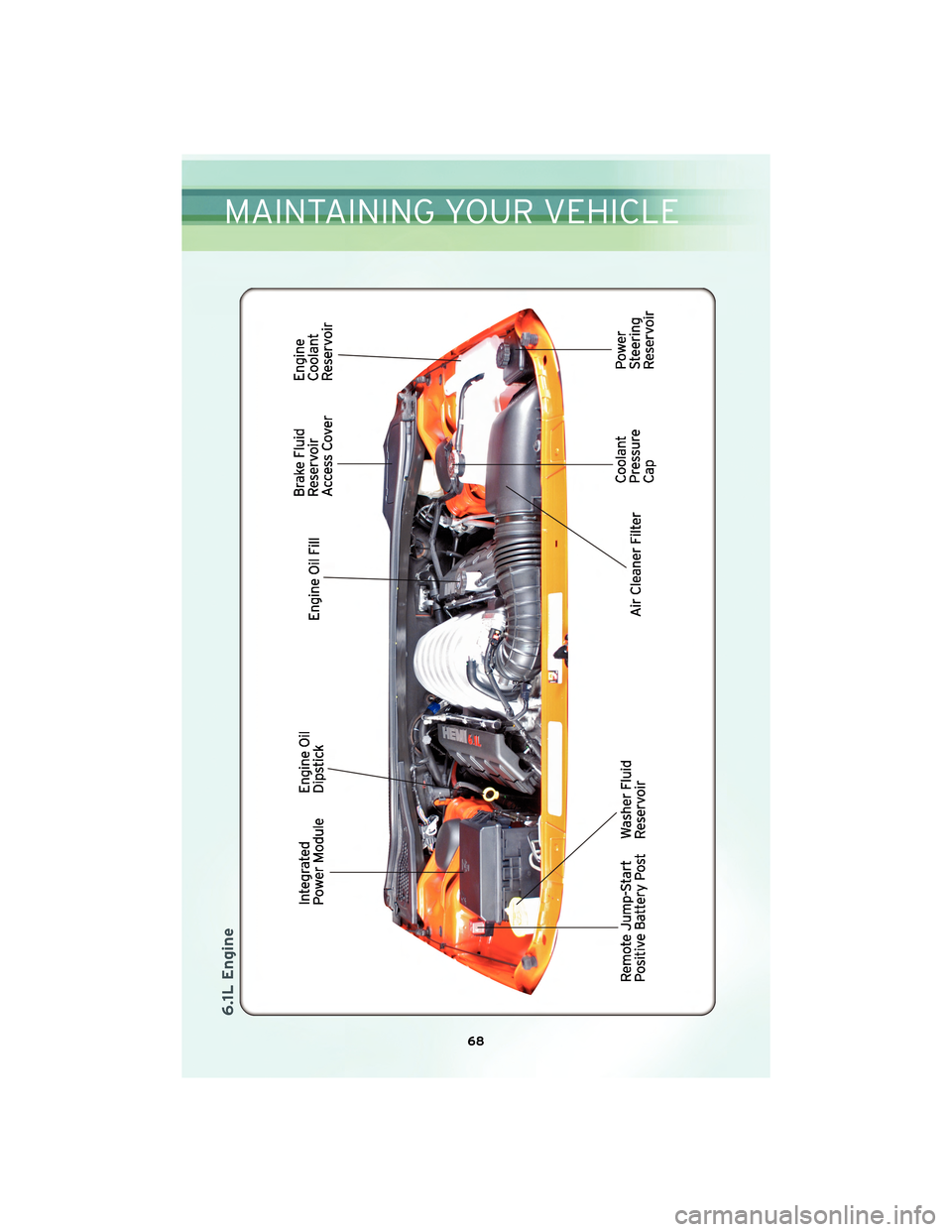CHRYSLER 300 2010 1.G Repair Manual
Manufacturer: CHRYSLER, Model Year: 2010, Model line: 300, Model: CHRYSLER 300 2010 1.GPages: 88, PDF Size: 11.01 MB
Page 61 of 88

WARNING!
Do not connect the cable to the negative post(-)of the discharged battery. The
resulting electrical spark could cause the battery to explode and could result in
personal injury.
• Start the engine in the vehicle that has the booster battery, let the engine idle a few minutes, and then start the engine in the vehicle with the discharged battery.
Once the engine is started, remove the jumper cables in the reverse sequence:
• Disconnect the negative (-)jumper cable from the remote negative (-)post of the
vehicle with the discharged battery.
• Disconnect the negative end (-)of the jumper cable from the negative (-)post of
the booster battery.
• Disconnect the opposite end of the positive (+)jumper cable from the positive (+)
post of the booster battery.
• Disconnect the positive (+)end of the jumper cable from the remote positive (+)
post of the discharged vehicle.
• If frequent jump-starting is required to start your vehicle you should have the battery and charging system inspected at your authorized dealer.
CAUTION!
Accessories that can be plugged into the vehicle power outlets draw power from
the vehicle’s battery, even when not in use (i.e., cellular phones, etc.). Eventually, if
plugged in long enough, the vehicle’s battery will discharge sufficiently to degrade
battery life and/or prevent the engine from starting.
59
WHAT TO DO IN EMERGENCIES
Page 62 of 88

TOWING A DISABLED VEHICLEModelFlat Towing (all four
wheels on the ground)Flatbed Towing (all
four wheels
suspended OFF the
ground)Front Wheels Raised,
Rear Wheels on the
Ground
Rear Wheels Raised,
Front Wheels on the
Ground
RWD Without a Key NOT Permitted Recommended Method NOT Permitted NOT Permitted
RWDWithaKey Shift lever must be in
NEUTRAL. The
distance to be traveled
must not exceed 15 mi
(24 km), and the
towing speed must not
exceed 30 mph
(48 km/h).Recommended Method May Be Used
NOT Permitted
AWD Without a Key NOT Permitted Recommended Method NOT Permitted NOT Permitted
AWDWithaKey Shift lever must be in
NEUTRAL and the
driveshaft must be
removed.Recommended Method NOT Permitted NOT Permitted
60
WHAT TO DO IN EMERGENCIES
Page 63 of 88

FREEING A STUCK VEHICLE
• If your vehicle becomes stuck in mud, sand or snow, it can often be moved by arocking motion. Turn your steering wheel right and left to clear the area around the
front wheels. Then, move the shift lever back and forth between REVERSE and 1st
gear. Using minimal accelerator pedal pressure to maintain the rocking motion,
without spinning the wheels, is most effective.
NOTE: If your vehicle is equipped with Electronic Stability Program (ESP) or
Traction Control
, turn the system off before attempting to “rock” the vehicle.
WARNING!
Fast spinning tires can be dangerous. Forces generated by excessive wheel speeds
may cause tire damage or failure. A tire could explode and injure someone. Do not
spin your vehicle’s wheels faster than 30 mph (48 km/h) when you are stuck. Do
not let anyone near a spinning wheel, no matter what the speed.
CAUTION!
• When “rocking” a stuck vehicle by moving between 1st and REVERSE, do not spin the wheels faster than 15 mph (24 km/h), or drivetrain damage may result.
• Revving the engine or spinning the wheels too fast may lead to transmission overheating and failure. It can also damage the tires. Do not spin the wheels
above 30 mph (48 km/h) while in gear (no transmission shifting occurring).
61
WHAT TO DO IN EMERGENCIES
Page 64 of 88

EVENT DATA RECORDER (EDR)
• In the event of an accident, your vehicle is designed to record up to five seconds ofspecific vehicle data parameters (see list below) in an event data recorder prior to
the moment of airbag deployment, or near deployment (if applicable), and up to a
quarter second of either high-speed deceleration data or change in velocity during
and/or after airbag deployment or near-deployment. EDR data is ONLY recorded if
an airbag deploys, or nearly deploys, and is otherwise unavailable.
NOTE:
• A near-deployment event occurs when the airbag sensor detects severe vehicle deceleration usually indicative of a crash, but not severe enough to warrant airbag
deployment.
• Under certain circumstances, EDR data may not be recorded (e.g., loss of battery power).
• In conjunction with other data gathered during a complete accident investigation, the electronic data may be used by Chrysler Group LLC and others to learn more
about the possible cau ses of crashesand associated injuries i n order toassessand
improve vehicle performance. In addition to crash investigations initiated by
Chrysler Group LLC, such investigations may be requested by customers, insurance
carriers, government officials, and professional crash researchers, such as those
associated with universities, and with hospital and insurance organizations.
• In the event that an investigation is undertaken by Chrysler Group LLC (regardless of initiative), the company or its designated representative will first obtain
permission of the appropriate custodial entity for the vehicle (usually the vehicle
owner or lessee) before accessing the electronic data stor ed, unlessordered to
image the data by a court with legal jurisdiction (i.e., pursuant to a warrant). A copy
of the data will be provided to the cust odial entity upon request.General data that
does not identify particular vehicles or crashes may be released for incorporation
in aggregate crash databases, such as those maintained by the U.S. government
and various states. Data of a potentially sensitive nature, such as would identify a
particular driver, vehicle, or crash, will be tr eated confidentially. Confidential data
will not be disclosed by Chrysler Group LLC to any third party except when:
• Used for resear ch purposes, such as to match data with a particular crash record
in an aggregate database, provided confidentiality of personal data is thereafter
preserved.
• Used in defense of litigation involving a Chrysler Group LLC product.
• Requested by police under a legal warrant.
• Otherwise required by law.
WHAT TO DO IN EMERGENCIES
62
Page 65 of 88

Data parameters that are recorded:
• Diagnostic trouble code(s) and warning light status for electronically-controlledsafety systems, including the airbag system
• Vehicle speed
• Engine RPM
• Brake switch status
• Pedal position
• And other parameters depending on vehicle configuration
63
WHAT TO DO IN EMERGENCIES
Page 66 of 88

OPENING THE HOOD
• Pull the hood release lever located below the steering wheel at the base of theinstrument panel.
• Reach into the opening beneath the center of the hood and move the safety latch lever while lifting the hood at the same time.
WARNING!
Be sure the hood is fully latched before driving your vehicle. If the hood is not fully
latched, it could open when the vehicle is in motion and block your vision. Failure
to follow this warning could result in serious injury or death.
MAINTAINING YOUR VEHICLE
64
Page 67 of 88

ENGINE COMPARTMENT2.7L Engine
65
MAINTAINING YOUR VEHICLE
Page 68 of 88

3.5L Engine
66
MAINTAINING YOUR VEHICLE
Page 69 of 88

5.7L Engine
67
MAINTAINING YOUR VEHICLE
Page 70 of 88

6.1L Engine
68
MAINTAINING YOUR VEHICLE